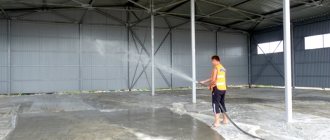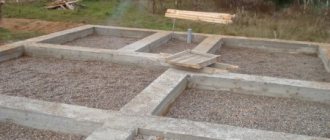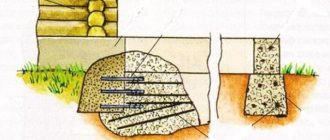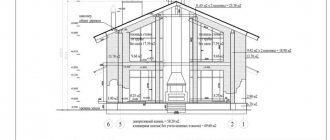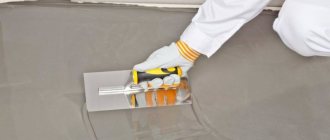There is no such thing as a finished foundation without a single crack (or almost never, but these exceptional cases do not apply to cottage houses). Sooner or later, under the influence of external or internal factors, defects may appear on it. There is no need to worry about this - the problem can be corrected with minor repairs, and you don’t even need to urgently hire a team of specialists. Many cracks can be dealt with on your own. The main thing is to make sure that they have not reached critical sizes and are suitable for repair.
Why can the foundation crack after pouring without load?
The reasons can be completely different. A novice builder could choose the wrong material, violate the pouring technology or design the structure - each stage has a great impact on the quality of the foundation.
To save money, many people neglect the quality of materials for preparing the mixture, formwork and fittings. This causes cracks to form in the newly poured foundation.
The strength of a structure is influenced by many factors. Not all of them depend on the builder, but many can be foreseen. Most often, the influence can be exerted not by one, but by a whole complex of reasons:
- Soil swelling due to excess moisture.
- Extreme heat or sudden changes in temperature at night.
- Incorrect installation of formwork, or an error in calculations.
- Exerting a load on a concrete mass that has not yet reached the required strength.
- The use of low quality concrete, which does not guarantee resistance to external influences.
- Incorrect choice of reinforcement section.
- Poor quality concrete compaction, resulting in air cavities inside.
- The solution is not cured properly.
- Corrosion of reinforcement.
- Temperature changes during the process of solution hardening or shrinkage.
- Violation of drainage technology, resulting in water entering the concrete base.
- Seismic or man-made changes in the soil - vibration from enterprises or neighboring construction sites.
If cracks are detected in the new foundation, repairs must be started immediately. Otherwise, precipitation and temperature changes will aggravate the situation and cracks will spread to the walls of the house.
Errors during the foundation pouring process
Sometimes the appearance of cracks in the foundation is a direct consequence of violations during foundation work. And, despite the fact that most builders do not consider a number of chips and cracks that occur to be very serious, their occurrence is by no means a norm that must be followed.
Indeed, most cracks are eliminated after repairing the base. But, in order to prevent them from appearing again, it is necessary to identify the root cause of their occurrence. Having understood the reason, you can choose the best way to solve this unpleasant problem.
Experts say that the most likely reasons for this destruction of the integrity of the surface are not only incorrect calculations, but also the attempt of home owners to construct the foundation with their own hands.
Among the miscalculations, the following errors are possible:
- incorrectly installed formwork, which does not allow the required solidity of the structure to be obtained after completion;
- poorly reinforced internal part of the foundation;
- insufficient depth of the foundation for seasonal freezing of the soil at this construction site;
- choosing the wrong quality of concrete for pouring, which does not guarantee resistance to soil influences and loads;
- discrepancy between the laid down characteristics of the foundation and changes in the structure during construction and after, for example, additional building of a floor;
- water entering the concrete base due to unmade or improperly performed drainage.
Is it possible to build a house if the foundation is cracked?
It depends on the size of the cracks. If their diameter is 0.1-0.3 cm, then it is enough to cover the gap with mortar and continue construction. Horizontal cracks are not dangerous, since they do not affect the integrity of the base. But the formation of vertical ones indicates a violation of the pouring technology, so erecting a structure is a waste of effort, time and money. Soon the house will sag or simply collapse under the influence of external factors. The best solution in this case would be to refill the damaged area, carefully following the technology.
Why can the foundation crack after winter?
After severe cold weather, the owner of a building may find that cracks have formed on the foundation and it has begun to crumble. The reason is seasonal changes in the soil: in winter, during severe frosts, the soil begins to freeze and shrink, and in spring, as the weather gets warmer, it expands. This can happen several times while there is snow on the street, and a concrete structure becomes a victim of unpredictable weather. As the foundation of the building is pushed out and deformed, the concrete begins to develop cracks.
If a brand of concrete with a high degree of hygroscopicity was used to prepare the concrete mixture, water will be “pulled” into the foundation. This will lead to cracks and tears in the spring.
What to do if the foundation is cracked
The first step is to find out why the crack occurred. If these are minor damages, then a non-professional can easily do it on his own and get away with re-plastering. But if this is caused by serious changes to the supporting structure of the building, then serious money will have to be spent on repairs, and it is unlikely that it will be possible to cope alone, without the involvement of professional workers.
First of all, you need to make sure that the crack does not grow further, for this you need:
- clean the recesses from dirt and small particles (best with a vacuum cleaner);
- rinse with water under pressure;
- install special plaster beacon markers on the top and bottom edges to monitor changes in the position of the cracks (the date can be written on them);
- if the marker has moved and torn, it means that the crack continues to grow and action needs to be taken.
If the situation does not get out of control, you must:
- just in case, clean the cracks again from dirt and rinse them with water;
- fill the crack with a primer;
- Wait until the primer dries a little, then fill all cracked areas with frost-resistant finishing gypsum, epoxy resin or cement mortar.
If there is serious deformation of the supporting structures, appropriate repairs are required, so you cannot do it yourself.
Strip foundation cracked
This is the most common type of structure, which is erected from individual beams under the load-bearing walls of the house. If the foundation of an already erected building is cracked, then this is a serious problem, the elimination of which will require a lot of expense. You will have to strengthen individual structural elements, raise segments of the base, and only then begin repairs.
There are several options for dealing with cracks:
- Strengthen the damaged area with a new brick wall or concrete blocks with additional reinforcement.
- Increase usable area. To do this, you need to dig a trench deep to the base of the foundation and equip the walls with formwork. Install reinforcement inside the trench, attach it to the foundation, then fill everything with concrete. Then dismantle the formwork and install waterproofing.
- Raise the building and strengthen the damaged area with special bored-type piles, strengthen the soil with a drainage system and arrange a heat-insulating blind area.
- You can use the injection method, i.e. injection of plastic concrete polymer material into cracks.
TISE foundation cracked
This is a type of universal pile or pile-grillage foundation. The base is strengthened by piles with enlarged ends in the shape of domes, and the house can be built even on heaving soils.
If a crack develops along the TISE foundation, then a reinforced and vibrated monolithic belt 30 cm high will have to be poured on top. The piles can be strengthened with an additional layer of earth so that they are below the freezing depth of the soil.
Cracked slab or monolithic foundation
A monolithic slab is considered a reliable type of foundation for a house, but it is not immune to the appearance of cracks, although they appear extremely rarely. If deep cracks appear, hard work will be required.
- In mild cases, inject epoxy resin. The most problematic areas can be secured with staples.
- Using special tapes or belts, tie the damaged area. The main thing is that they contain Kevlar fiber. This method can be combined with injection.
- In case of critical damage, you will have to dig under the slab, strengthen the foundation in places where there are splits, and remove those parts that can no longer be restored. It is also necessary to fill the damaged area with a new layer of concrete and install pile or block supports.
Foundation corner cracked
The corners can be fastened with special staples and filled with mortar. To do this, you need to drill holes in the concrete and seal them with a polymer fastening material - plastic concrete.
In combination with other methods, additional supports or piles will have to be installed.
Repairing simple cracks
Repair of simple shrinkage cracks is carried out in several steps:
- First, the crack cavity is cleared of dust and washed with water.
- Afterwards, the dry crack is coated to the full possible depth with a primer for external use.
- The crack cavity is filled with special sealants or cement mortar with a cement grade of at least 500.
Clearing a simple crack
Let's figure out how to fix cracks in the foundation. The method of performing the work is determined taking into account the type of materials used to construct the external walls of the facility. If a crack has formed in the foundation of a wooden house, then the work is carried out according to the same scheme; for stone and block structures, the technology for repairing cracks in the foundation will be different:
- the foundation of the structure made of stone or blocks is made of reinforced concrete frames mounted on each side of the foundation structure;
- Cracks rarely appear on the foundation of a private house made of wood, but when this happens, you can lift the building with jacks, having first freed it from furniture;
- how to repair cracks in the foundation of a brick building? There are two ways to do this: the basement wall is filled with concrete, but before that a steel frame is placed around the entire perimeter; Boring injection pile supports are installed. The second method is more effective, it helps restore an almost destroyed foundation, but the cost of the work is quite high.
How are simple cracks in the foundation repaired after pouring? The algorithm of actions is as follows:
- the gap is cleaned of dirt, washed and dried;
- the entire depth of the crack is treated with a primer intended for treating external surfaces;
- void areas are filled with sealants or cement mortar M 500.
What to do when the foundation and wall are cracked
If a small defect appears on the wall, this is not a reason to panic. Small cracks are completely acceptable. It is not the wall that may crack, but only the finishing layer. First of all, you need to examine the base and observe the crack with the help of a beacon until it finally becomes clear that the crack went along the wall.
Ways to determine the cause of the problem:
- A vertical crack diverges upward - swelling of the soil;
- The vertical diverges from the bottom - subsidence of the soil in the middle, or swelling in the corners of the wall due to freezing on the sides;
- Sloping from the center to the corner - settlement of the backfill of the adjacent wall
- Several arch-shaped cracks indicate that the soil has subsided in the central part.
In any case, the situation is serious and the foundation will have to be strengthened. This can be done in several ways:
- Raise sagging areas with jacks to the desired level.
- Drill 20-40 mm holes to immerse injectors into them.
- Fill all voids with synthetic resins, hot bitumen or liquid glass.
Did you manage to restore the foundation of the house?
Yes
No
How to strengthen the foundation depending on the type of building
The method of strengthening depends on the material used to make the walls, the purpose of the structure and the expected load.
Brick house
If the house is brick, then cracks will be a typical problem for the owner due to the enormous loads. The soil underneath may begin to settle and for this it will be necessary to erect a reinforcing belt on both sides. The technology is as follows:
- Dig a trench 50 cm wide, at an angle of 35 degrees (but do not expose the base of the foundation).
- Clean the surface of the base from dirt, remove damaged parts.
- Treat the working surface with a deep penetration primer.
- Drill holes 60-120 cm horizontally in three or four rows.
- Drive anchors into them and weld them with reinforcement with a diameter of 1-1.4 cm.
- Deep crevices, as well as the most damaged areas, should be filled with concrete using local formwork.
- Erect a reinforcing mesh, make formwork (5-15 cm to the base) and fill everything with concrete.
House made of aerated concrete
Very often, cracks in the foundation of such a structure can appear after the first winter. To cope with the problem you will have to strengthen:
- Cast a reinforced belt to tie the existing foundation.
- The aerated concrete walls are covered with a metal frame. This can be done in two ways: drill anchors into the walls of the house and weld them with a metal profile, or tighten the walls along all external sides with a profile pipe.
- To increase rigidity, fix the metal channel vertically to the walls.
- You can drain water to get rid of excess moisture around your home.
How to repair a crack in the foundation
Often, the occurrence of cracks in the foundation of a house is an inevitable event. But there's no need to panic. You should carefully understand what caused this process and quickly solve this problem. This article will discuss how to repair a crack in the foundation.
Causes of cracks and their main types
The most common causes of cracks include:
- poor-quality soil preparation for the foundation;
- savings on the purchase of materials for construction;
- natural soil shifts;
- non-compliance with house construction technology;
- construction of a new facility nearby.
There are two main types of cracks on the foundation surface:
- horizontal;
- vertical.
Horizontal cracks do not pose such a danger. They can occur for various reasons. The main ones are:
- exposure to low temperatures (concrete dries out);
- increased pressure from wet soil.
Long cracks and horizontal faults with bulges on the external wall of the house indicate possible displacement of the foundation or pressure exerted on load-bearing walls. To determine the specifics of faults, you should use a level. If there is a bulge of more than 1 cm or a ridge has formed on the edge of the wall, major repairs to the base are necessary.
What to do when the crack in the foundation is vertical? Such breaks in the walls do not bode well. If there is only one crack at the base of the building, its parameters need to be determined. If there is a fault with smooth edges and a small thickness (about a hair's breadth), repairing a crack in the foundation will not be difficult.
More difficult work lies ahead when the vertical edges of the fault are uneven and the gap widens in any direction. It should also be taken into account that the crack can be located underground. In this case, you need to excavate the entire area near it.
Technology for sealing faults in the foundation
Depending on the complexity of the job, sealing cracks in the foundation will require different materials. When the faults are small, they are sealed using a regular repair mixture or sealant. More complex areas are treated with special materials. These include epoxy resin and quick-hardening cement.

